All the Colours of Peristil: New Art Installation Has Split Square Dressed in Gold
February 23rd, 2022 - Named ‘Set the Bird Free, Lock Up the Weapons’, the new art installation at Peristil is only the latest in line of numerous interventions in the famous Split square
The Peristil Square in Split was covered in gold yesterday as part of an art intervention that also features an oversized gun locked in a gigantic cage. As reported by Slobodna Dalmacija, a plaque is displayed on the cage, inscribed with a short message - Imagine.
Created by Swiss-based gallerist Miloš Glavurtić, the artwork is named ‘Set the Bird Free, Lock Up the Weapons’. The pacifist message of the installation is reinforced with the sheet of gold covering the entire surface of the square, possibly alluding to the fact that wars are a lucrative business and are started with financial profit as a driving force.
The art installation is inspired by an earlier work of Croatian conceptual artist Vladimir Dodig Trokut, who in 1991 displayed a gun locked up in a bird cage, and titled the installation ‘The Songbirds’ Song’.
The golden attire is only the latest in line of many art interventions staged at Peristil as a means of protest against various social and political affairs.
Arguably the most famous event of its kind that took place on the square, the legendary Red Peristil was a daring act of a group of Split college students led by artist Pavle Dulčić. In 1968, they painted the entire square red, causing a scandal in the local community.
 Red Peristil / Source: Petar Grimani, Facebook
Red Peristil / Source: Petar Grimani, Facebook
Seen as an act of vandalism at the time and condemned as a show of disrespect of cultural heritage, the act was later recognised as having artistic quality and is nowadays remembered as one of the first art interventions in these parts.
Twenty years later, Peristil turned green in an intervention staged by multimedia artist Ante Kuštre. Unlike his predecessors, Kuštre didn’t use paint to create his Green Peristil, but covered the square in green panels to raise awareness of environmental issues and bring attention to a deficit of green spaces in the city of Split.
On January 11th 1998, artist Igor Grubić marked the 30th anniversary of the Red Peristil with a work of his own. In the early hours of the morning, Grubić painted the square with a six-metre wide blotch of black.
The artist taped a note on the door of the Tourist Board office, saying: ‘In honour of the Red Peristil group 30 years later. Like a magic mirror, Peristil reflects the state of social consciousness. Black Peristil’.
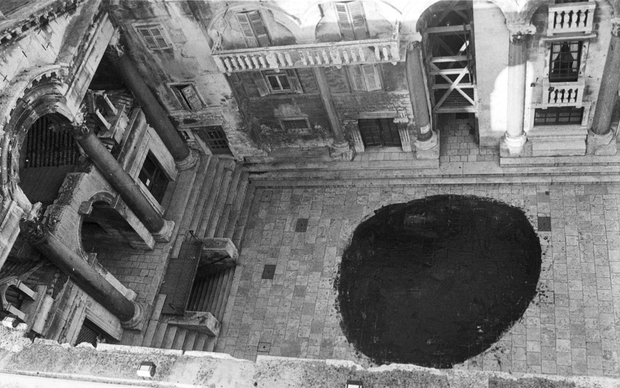 Igor Grubic, Black Peristil, 1998
Igor Grubic, Black Peristil, 1998
At the time, it wasn’t known who was responsible for the act, until Grubić went public months later as the author of the work that was meant to contrast ‘red history’ against ‘the dark present’.
The Peristil of Light was an ambient installation put up on two occasions, on Christmas 1991 and on Christmas 1997, by the painter Alieta Monas. It was a square of light that was placed on the northwest tower of Diocletian's Palace, together with a round piece of red cloth.
The legendary Red Peristil seems to have been a source of inspiration for many, including the artist Petar Grimani who marked the 40th anniversary of the controversial work by launching 40 flares in the main courtyard of Diocletian’s Palace. Named the Flying Peristil by the media, the action had the space lit red for a short period of time.
In 2009, Torcida staged a protest of their own, covering the square with an enormous yellow plastic bag inscribed with the word 'Kodeks' in blue, altogether reminiscent of shopping bags specific to the company Kerum.
The action was meant as a protest against ‘Kerumisation of Hajduk’, i.e. entrepreneur and then Mayor of Split Željko Kerum installing his acquaintances in high positions in Hajduk management.
Dubbed Yellow Peristil by the media, the intervention was condemned by the local authorities, with the mayor stating it wasn’t an art installation but a work of extremists helping the opposition to bring down the city leaders. Torcida in turn stated they were no one's puppet, but only wanted for the leading people of Hajduk to be selected on the basis of merit and expertise.
Next we have the Glass Peristil, a project that took place in the virtual world instead on the Split square. It was designed by art historian and artist Nikola Bojić, who in 2008 anonymously shared a project with the media, signed only as Majorian 458. It was an imaginary architectural project which envisaged construction of a commercial and residential building made of glass on the Peristil square, complete with helipads in the Vestibule and underground garages in the Diocletian’s Cellars, were connected to the Peristyle by escalators.
Even though the project obviously wasn't real and was meant to start a discussion about the need of putting culture before profit when designing public spaces, sensationalist headlines sent the public into a frenzy, and the work was called a ‘terrorist attack on public space, cultural monuments and the historic urban environment’.
And finally, we're back where we started, with gold being the latest colour to adorn the Peristil Square.
Learn the Old Folk Dances of Split with KUD Jedinstvo!
KUD Jedinstvo will spend every Thursday this summer teaching the people of Split the famous folk dances of the city.
Swedish Travel Blogger Shares Breathtaking Photos of Split
Split through the eyes of the Swedish Nomad.
Changing of Diocletian's Guards Returns to Peristyle on Monday
Diocletian's guards return to Peristyle!
Sites in Split: Peristil
In Roman architecture, a peristyle is an open colonnade surrounding a court; hence the name of the central court in Diocletian’s Palace is called Peristil. It is located at the intersection of the two main streets, cardo and decumanus .The nucleus of historical sites is found here, with the prothyron, sphinxes, vestibule, various palaces, and the imposing Cathedral of St. Domnius, and Diocletian’s mausoleum as surrounding this popular square.
The 27-meter long and 13,5-meter wide imperial square is framed by two colonnades to the east and west, a prothyron to the south leading to the vestibule and further to the imperial quarters. Most of the structure is made of white stone from the nearby island of Brač however; the columns are made of Italian marble and siennite from Egypt.
Actually, Emperor Diocletian was a great lover of Egypt, which is apparent as he acquired the Peristil columns and more than a dozen granite sphinxes (from 1500 BC) from Luxor. Three sphinxes remain today; one is still located onPeristil, the second sits headless in front of the Jupiter's temple, and the third is in the city museum.
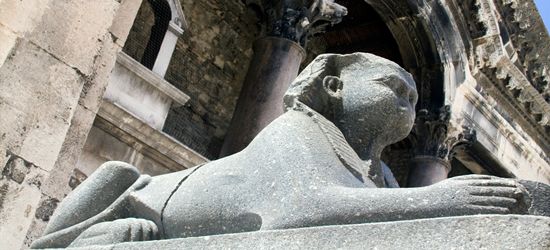
Sphinx: Image by interyachtcharter.com
The head of Peristil, the prothyron, connecting the public square to the private quarters was the only place a commoner would see the emperor as he addressed his people. The prothyron has four columns, which support a triangular gable with an arch in the center. On either side of the prothyron you will find a little chapel stemming from far after the time of Diocletian; Our Lady of the Belt (1544) and Our Lady of Conception (1650).
Behind the prothyron, you will enter a vestibule, a foyer that leads you into the emperor’s residential quarters. Known as “Vestibul,” this circular room is topped by a cupola which was once covered in mosaics and marble. Today the center of the dome is no longer there, providing clear views to the skies above. The Vestibul provides great acoustics allowing klapa bands to perform traditional a-cappella songs there in the mornings.
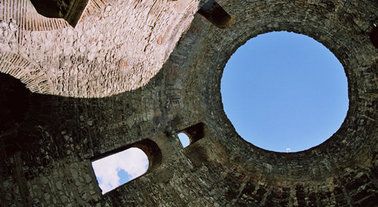
To the east of Peristil is the Cathedral of St. Domnius (Katedrala Sv. Duje or Sv. Dujam), where Diocletian’s mausoleum is also located; quite an oxymoron as the emperor was a known prosecutor of Christians. The cathedral consists of the octagonal mausoleum and now main part of the church and the Romanesque belfy towering above the city (see section on Cathedral of St. Domnius for further information).

Cathedral: Image by neilmeyerhoff.com
At the end of the eastern colonnade is the Renaissance-style Chapel of St. Roch (Crkvica Svetog Roka) built in 1516. Today is houses the main tourist information office.
Much later, three palaces were built along the eastern colonnade of Peristil. Closest to the prothyron is the Skočibučić-Lukaris Palace showing characteristics of a few architectural eras; Romaneque elevations to allow access through the pillars, Renaissance windows and portal, a Baroque balcony, and a Classicist third floor. This palace will be the future home of the Museum of Ecclesiastical Arts. Next up is the Cipci Palace, where the popular Luxor café is partially housed, mixing Roman, Late Gothic, Renaissance, and Baroque Styles. Inside the café, you will sit in a Roman loggia and you will notice a marble circle on the floor, stemming from the previous Temple of Venus. The last structure along the pillars is the stunning 13th century Grisogono Palace, which was later, renovated into a Gothic style. If you can pay a night in the luxury apartments here you will enjoy the magnificent UNESCO protected ceilings featuring elaborate Gothic frescoes. The Grisogono family is the oldest living family in Dalmatia.
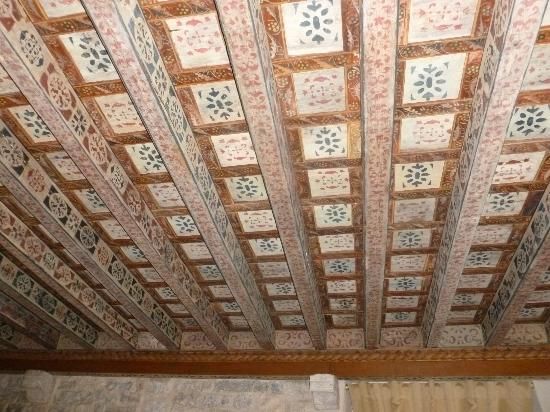
Ceiling of Grisogono Palace: Image from tripadvisor.com
Peristil is the host to various events through the year most notably the Split Summer Festival where the square converts into an open-air opera theatre.
Fun facts: The Statue of Grgur Ninski was originally erected on Peristil but was severed into three pieces and dug underground in order to hide it from occupying forces in the Second World War. After the war it was re-erected and today is stands at the exit of the Golden Gate. Two other copies of the statue exists; in Nin and Varaždin. Later, the entire floor of Peristil was illegally painted red on January 11,1968 by an activist group demonstrating against communism in the former Yugoslavia.
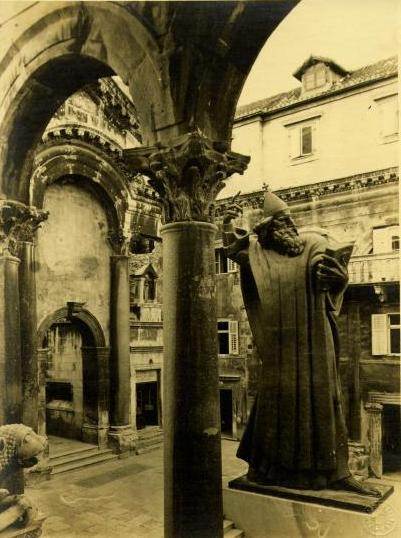
Grgur Ninski on Peristil: Image from croatia.ch
Lvxor Kavana: The Oldest Café in Split?
Grab a pillow from the pile and choose your spot on the Peristil steps, whether it be a midday chat with a friend, people watching, live music under the stars or a Sunday salsa show, Lvxor Kavana gives you the resource to absorb the city vibe.
Lvxor Kavana is located smack bang in the center of the palace action, on the Peristil Square adjacent to the Cathedral of St. Domnium (Sv. Duje). The name Lvxor (pronounced Luxor) refers to the Egyptian city where Diocletian brought the nearby sphinx and columns and the sign above the café door is clearly old. The interior of the café is magnificent and it is a tourist attraction in its own right; the medieval loggia, the marble circle on the floor, which is the base of the Temple of Venus, the exposed walls, and ceiling murals is a reminder of the many architectural histories this palace has passed.
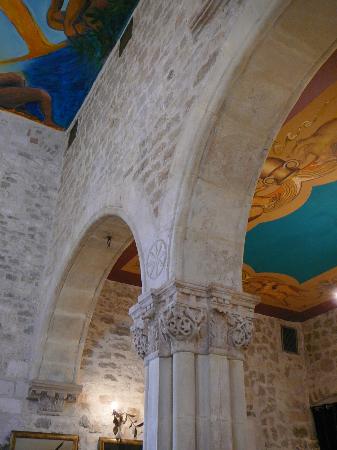
The warm interiors of Lvxor offer a comfortable escape from the bura winds in the winter months where you can lean back and sip your tea and flavour some spectacular cakes amongst which the white chocolate cheese cake is a favourite. The upperfloor has a smoking and cigar room. During the summer months, Lvxor Kavana has live music playing on Peristil almost every evening from 20:00 and on Sundays the city’s salsa enthusiasts gather here to dance, encouraging beginners and tourists to join in on the fun.
Rumours have it that Lvxor Kavana is the oldest café in Split. Do you know?
Kraj Sv. Ivana 11
21 000 Split
Hrvatska
T: +385 (0) 21 341 082


